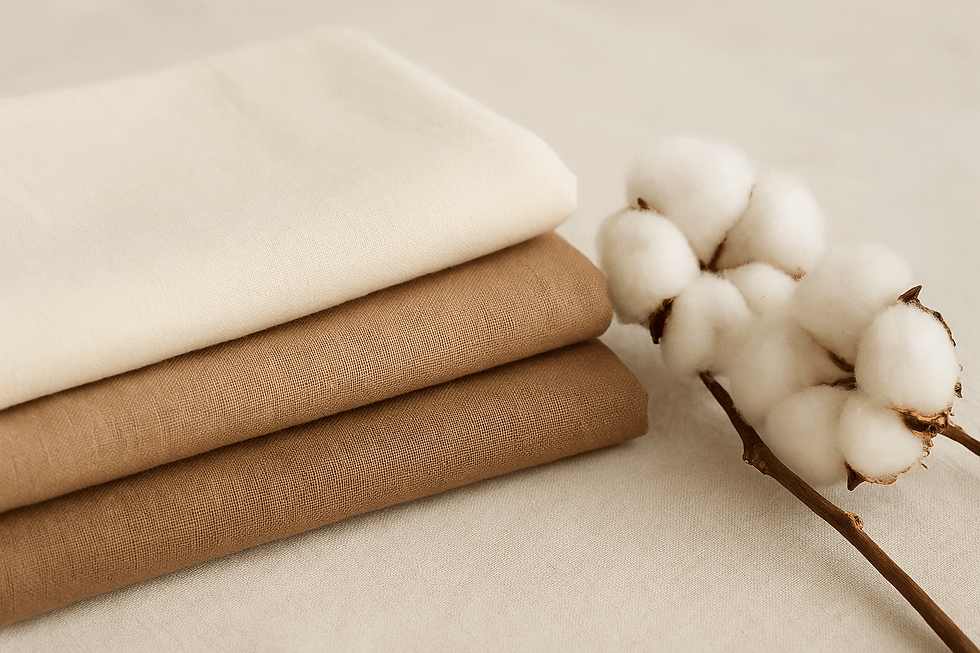The Complete Guide to Handloom Fabric: Craftsmanship, Quality, and Export Opportunities
- Team SC
- Oct 31
- 3 min read
Updated: Nov 14
In an era where conscious sourcing and craftsmanship define the fashion industry, handloom fabric stands as a timeless expression of heritage and sustainability. Woven by skilled artisans on traditional looms, each meter of handloom fabric carries a story of artistry, culture, and care.
As global demand for eco-conscious and ethically sourced textiles rises, Indian handloom fabric suppliers are bridging tradition with innovation. They offer buyers access to authentic, premium-quality fabrics for modern design and production needs.
This guide explores the world of handloom fabric, its craftsmanship, benefits, and how exporters like Source Creative are connecting international markets with India’s handloom heritage.
Understanding Handloom Fabric
Handloom fabric is produced manually using traditional looms operated by artisans without electricity. This process preserves centuries-old weaving techniques and ensures minimal environmental impact.
Each weave reflects regional artistry, from the elegance of Maheshwari to the intricate Ikat and delicate Jamdani. These fabrics are known for their durability, breathability, and natural aesthetic appeal, making them highly valued by fashion designers and manufacturers worldwide.
Why Handloom Fabric Matters in Today’s Textile Industry
Cultural Legacy: Handloom weaving sustains millions of artisan families across India and preserves traditional craftsmanship.
Sustainability: It consumes less energy, uses eco-friendly fibers, and reduces carbon footprint compared to mechanized manufacturing.
Unique Quality: Each handloom piece is distinct, with subtle variations in texture and color that make it exclusive.
Market Demand: Global consumers increasingly prefer authentic, traceable, and handmade products that reflect sustainability.
The handloom sector contributes to nearly 15% of India’s total cloth production and employs over 3.5 million weavers. It remains one of the largest cottage industries in the world.
The Craftsmanship Behind Handloom Fabric

Handloom weaving is a slow, skill-intensive process involving several stages. It starts with yarn preparation, where cotton, silk, or linen fibers are spun into threads. The yarn is then dyed with natural or azo-free colors to achieve rich, long-lasting hues.
Warping and weaving follow, where threads are arranged and woven by hand to create intricate patterns. Finally, the fabric is washed, dried, and softened to prepare it for use in garments or furnishings.
Key Industry Insights and Trends
The global shift toward ethical fashion and slow production has significantly increased the demand for handloom and sustainable textiles. International brands now source directly from handloom suppliers and exporters to ensure transparency and authenticity.
Customization is also on the rise, as exporters offer modern handloom fabrics in contemporary blends and patterns. With digital platforms expanding, buyers can easily buy handloom online or order handloom fabric wholesale directly from Indian exporters.
Export Opportunities for Handloom Fabric
India remains a leading exporter of handloom fabric to markets such as the United States, the United Kingdom, Japan, and Europe. As more fashion brands adopt sustainable sourcing, the demand for handcrafted textiles continues to grow.
Exporters like Source Creative specialize in connecting international buyers with India’s finest handloom fabrics. Their focus on quality, sustainability, and client satisfaction positions them as trusted partners for global textile sourcing.
Benefits for Buyers and Brands
Partnering with reliable handloom fabric suppliers offers distinct advantages. It supports sustainable production while helping brands reduce their environmental impact. Each fabric’s handcrafted uniqueness provides product differentiation that appeals to conscious consumers.
Buyers also benefit from transparent supply chains and the ability to customize fabrics for apparel, home décor, and luxury lines. Handloom fabrics deliver durability and artistic appeal, adding long-term value to collections.
How to Source Handloom Fabric from India
Research Authentic Suppliers: Work with exporters like Source Creative who maintain quality control and direct collaboration with weavers.
Request Samples: Review fabric texture, weave density, and finishing before placing bulk orders.
Negotiate Wholesale Orders: Discuss minimum order quantities, customizations, and shipping logistics.
Verify Sustainable Practices: Ensure suppliers follow eco-friendly production and fair trade standards.
Finalize Export Terms: Agree on lead times, payment terms, and post-delivery support.
The Future of Handloom Exports
As sustainable fashion continues to influence global markets, the Indian handloom industry is poised for rapid growth. Innovation in design, improved digital access, and responsible sourcing practices are aligning heritage craftsmanship with modern fashion needs.
Indian exporters are now blending tradition with technology, ensuring that handcrafted fabrics remain relevant and desirable in contemporary fashion.
Conclusion
Handloom fabric represents the perfect combination of craftsmanship, sustainability, and timeless appeal. With growing awareness of ethical sourcing, global buyers increasingly turn to India for high-quality handloom fabric wholesale.
Source Creative, a trusted supplier and exporter of premium handloom fabrics, connects international businesses with authentic, artisan-made materials. Their dedication to quality and transparency makes them a preferred partner for sustainable sourcing.



Comments